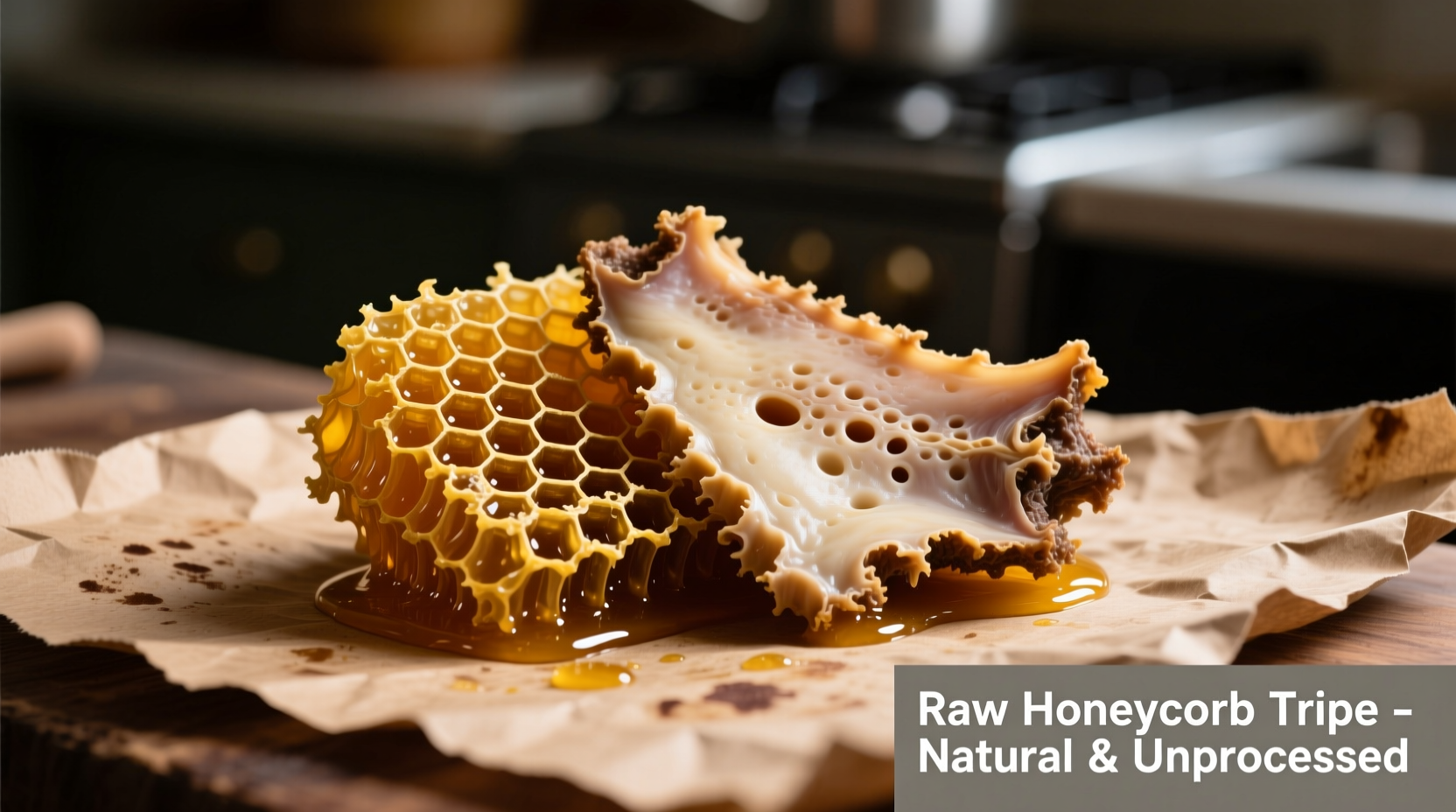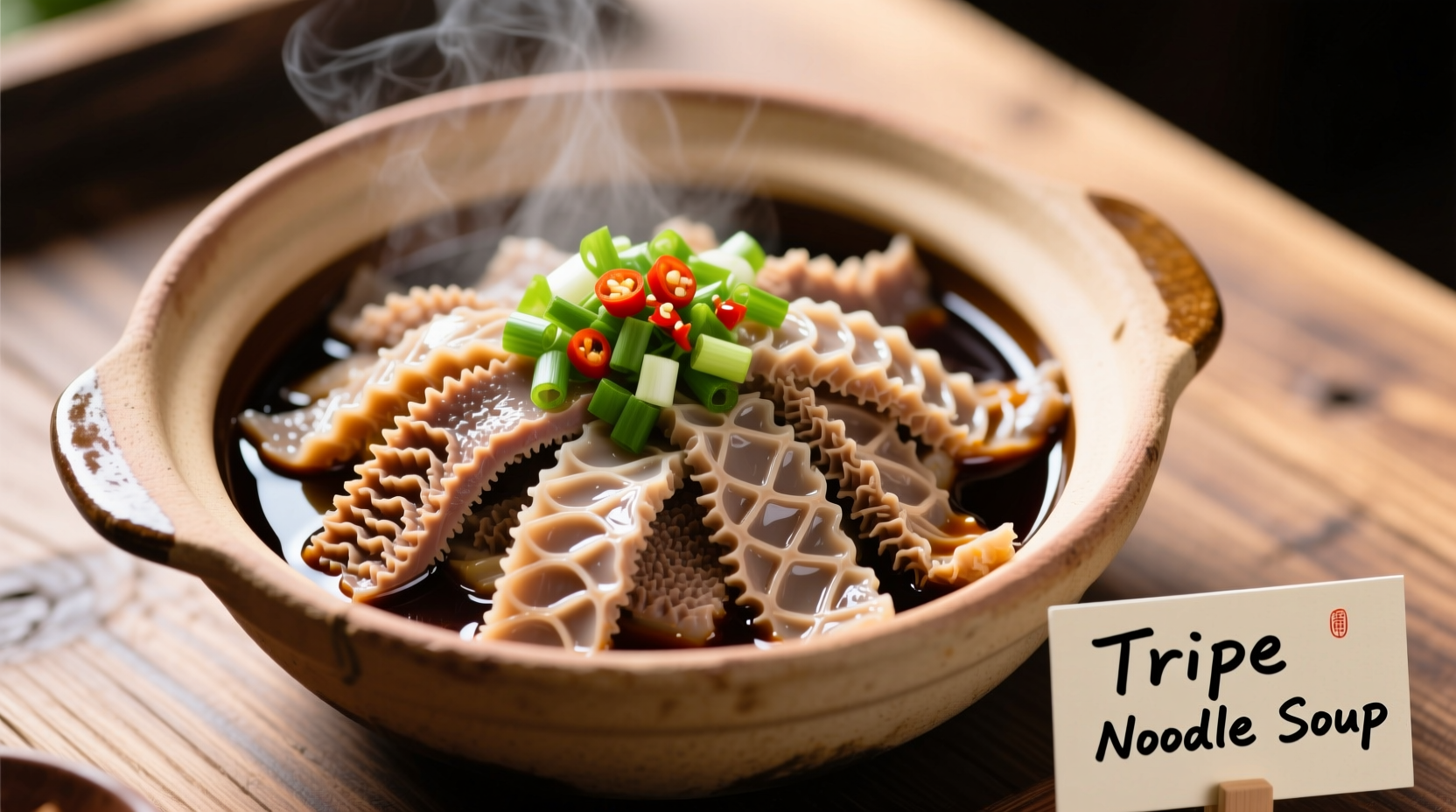Curious about this traditional ingredient that appears in cuisines worldwide? You're not alone. Understanding what tripe food actually is—and why it's valued across cultures—can transform your perspective on this misunderstood culinary treasure. Whether you've encountered it in Mexican menudo, Scottish haggis, or Chinese hot pot, tripe represents one of humanity's oldest approaches to sustainable eating.
What Exactly Is Tripe? Understanding the Basics
Tripe refers specifically to the cleaned and prepared stomach lining of ruminant animals, most commonly cattle. Unlike other organ meats, tripe comes exclusively from the multi-chambered stomachs of animals like cows, sheep, and goats. The most prevalent form in Western markets comes from beef stomachs, featuring three distinct chambers used as food:
| Tripe Type | Source Chamber | Texture Characteristics | Common Culinary Uses |
|---|---|---|---|
| Honeycomb Tripe | Second stomach (reticulum) | Porous, honeycomb-like pattern | Menudo, pho, Italian trippa |
| Blanket Tripe | First stomach (rumen) | Smooth, flat surface | Stews, braises, Scottish haggis |
| Book Tripe | Third stomach (omasum) | Layered, leaf-like structure | Traditional European dishes |
Each type offers different textures and absorption qualities, making them suitable for specific cooking methods. Honeycomb tripe, with its distinctive pattern, remains the most widely available in supermarkets due to its ability to absorb flavors while maintaining structure during long cooking processes.
The Historical Journey of Tripe Across Cultures
Tripe consumption dates back to ancient civilizations when resourcefulness in food preparation was essential for survival. Historical evidence shows tripe appearing in Roman cookbooks from the 1st century AD, while medieval European cookery frequently featured "umble pie" made from deer innards. The practice spread globally through cultural exchange and migration patterns:
- Pre-Columbian Americas: Indigenous communities utilized all parts of hunted animals, including stomach linings
- 16th-19th centuries: European settlers introduced tripe dishes to the Americas, blending with local ingredients
- 20th century: Tripe became associated with working-class meals during economic hardships
- Present day: Tripe has experienced a culinary renaissance as chefs rediscover traditional nose-to-tail cooking
According to the Food and Agriculture Organization of the United Nations, offal consumption remains significant in over 70% of global cultures, with tripe featuring prominently in traditional dishes from Mexico's menudo to Korea's gopchang. This enduring presence demonstrates tripe's nutritional value and cultural importance across diverse societies.

Nutritional Benefits and Dietary Considerations
Tripe offers impressive nutritional advantages that often surprise first-time consumers. A 3-ounce serving of cooked beef tripe provides:
- Nearly 10 grams of high-quality protein
- Significant amounts of selenium (40% of daily value)
- Substantial vitamin B12 (30% of daily value)
- Notable zinc and iron content
- Only about 120 calories per serving
Data from the USDA FoodData Central confirms tripe's nutritional profile makes it valuable for maintaining healthy digestion and supporting immune function. However, those with specific dietary restrictions should note that tripe contains moderate cholesterol levels (approximately 220mg per 3-ounce serving) and requires thorough cooking to ensure food safety.
How to Prepare Tripe: From Market to Plate
Proper preparation transforms tripe from an intimidating ingredient into a culinary delight. When purchasing tripe, you'll typically find three forms:
- Fresh tripe: Requires extensive cleaning and bleaching (often sold pre-cleaned in Western markets)
- Pre-cooked tripe: Ready for final cooking stages, significantly reducing preparation time
- Canned tripe: Fully cooked and preserved, requiring only rinsing before use
The cleaning process traditionally involves multiple rinses with vinegar or lemon juice, followed by boiling with aromatics to remove any residual odors. Modern commercial preparation typically follows FDA food safety guidelines ensuring tripe reaches safe internal temperatures during processing.
Cooking tripe properly requires patience—most methods involve simmering for 2-4 hours until the texture becomes tender yet slightly chewy. The stomach lining's unique structure absorbs surrounding flavors exceptionally well, making it perfect for broths and spice-infused dishes. Professional chefs recommend adding tripe to cold liquid and gradually bringing it to a simmer to preserve texture.
Global Tripe Dishes Worth Trying
Tripe's versatility shines across international cuisines. Some notable preparations include:
- Mexican Menudo: A comforting soup featuring honeycomb tripe, red chili broth, and hominy, traditionally served for weekend gatherings
- Vietnamese Pho: Some regional variations incorporate tripe for added texture in the famous noodle soup
- Italian Trippa alla Romana: Honeycomb tripe stewed with tomatoes, pecorino, and mint
- Korean Gopchang: Grilled beef intestines and tripe, often served with spicy dipping sauces
- British and Irish Tripe and Onions: Simmered with onions in a light broth, sometimes fried as a breakfast item
These dishes demonstrate how different cultures have developed unique approaches to preparing tripe, transforming what might seem like an unusual ingredient into beloved comfort foods. The global appreciation for tripe reflects both practical resourcefulness and sophisticated culinary traditions.
Common Misconceptions About Tripe
Several myths persist about tripe that often deter curious cooks. Let's address the most common misunderstandings:
- "Tripe tastes strongly of stomach": Properly cleaned and cooked tripe has a mild, slightly sweet flavor that readily absorbs surrounding seasonings
- "Only poor people eat tripe": Historically valued by all social classes, tripe appears in medieval French cuisine and was served in royal courts across Europe
- "Tripe is difficult to prepare": Modern markets offer pre-cleaned, pre-cooked tripe that significantly simplifies preparation
- "All tripe is chewy": Different cooking methods yield varying textures—from tender in soups to pleasantly chewy in grilled preparations
Understanding these realities helps demystify tripe and encourages culinary exploration. Food historians note that tripe's reputation fluctuates with economic conditions—during times of abundance, offal consumption often decreases, while resource-conscious periods see renewed interest in these nutrient-dense ingredients.
Getting Started With Tripe Cooking
For those ready to explore tripe cooking, these practical steps will ensure success:
- Start with pre-cleaned, pre-cooked tripe to minimize preparation challenges
- Begin with established recipes from cultures known for tripe dishes (Mexican, Italian, or Asian)
- Pair tripe with strong flavors like tomatoes, chilies, or garlic that complement its mild taste
- Allow sufficient cooking time—most tripe benefits from slow simmering
- Experiment with different tripe types as you gain experience
Local butchers and international markets often provide the freshest options, while many mainstream supermarkets now carry pre-cooked tripe in their international or specialty meat sections. Frozen tripe maintains quality for several months when properly stored.











 浙公网安备
33010002000092号
浙公网安备
33010002000092号 浙B2-20120091-4
浙B2-20120091-4